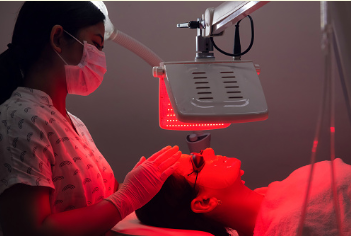Are you currently on antibiotics and wondering if you can still reap the benefits of red light therapy? The answer is yes, you can! Red light therapy, also known as photobiomodulation, is a safe and non-invasive treatment that uses red and near-infrared light to stimulate healing and improve overall well-being.
While antibiotics fight off bacterial infections, red light therapy works at the cellular level to promote tissue repair, reduce inflammation, and enhance circulation.
The good news is that there is no known interaction between red light therapy and antibiotics. You can continue with your red light therapy sessions without any worries. Combining the two treatments may have synergistic effects, as red light therapy can help support your body’s natural healing process while antibiotics target the infection.
However, it is always important to consult your healthcare provider before starting new treatments, especially if you have any specific concerns or medical conditions. They can provide personalized advice and ensure that red light therapy is safe and suitable for you while on antibiotics.
So, go ahead and enjoy the rejuvenating benefits of red light therapy without any hesitation!
Antibiotics
Antibiotics are medications that help fight bacterial infections by killing or inhibiting the growth of bacteria. They’re commonly used to treat infections such as urinary tract infections, respiratory infections, and skin infections.
However, it’s important to note that antibiotics can have side effects, including gastrointestinal issues such as diarrhea, nausea, and stomach pain.

1. Explanation of antibiotics and their role
Antibiotics are crucial in fighting bacterial infections, but have you ever wondered how they work? Well, let me explain.
Antibiotics are medications that either kill bacteria or prevent them from growing and multiplying. They target specific parts of the bacterial cell, such as the cell wall or the machinery needed for reproduction. By disrupting these critical functions, antibiotics eliminate the bacteria causing the infection.
It’s important to note that antibiotics only work against bacterial infections, not viral infections like the common cold or flu. Additionally, it’s essential to take antibiotics exactly as your healthcare provider prescribes to ensure the best outcomes and prevent the development of antibiotic resistance.
So, remember their vital role in fighting bacterial infections next time you’re prescribed antibiotics.
2. Common reasons for antibiotic usage
When you’re feeling under the weather, there are several common reasons you might be prescribed antibiotics. One of the most common reasons is a bacterial infection, such as strep throat or urinary tract infection. Antibiotics are also commonly prescribed for respiratory tract infections like bronchitis or sinusitis.
Your doctor may prescribe antibiotics if you have a skin infection, such as cellulitis or impetigo. Additionally, antibiotics may be used to treat certain sexually transmitted infections, like chlamydia or gonorrhea. In some cases, antibiotics may also be prescribed to prevent infection after surgery or to treat dental infections.
Remember, it’s essential to take antibiotics exactly as prescribed and to finish the entire course, even if you start feeling better.
Purpose of antibiotics and their effects
While taking antibiotics, it’s essential to understand their purpose and how they can affect your body.
Antibiotics are medications used to treat bacterial infections. They work by killing or inhibiting the growth of bacteria, thus helping your body fight off the infection. Antibiotics can be a powerful tool in combating illnesses caused by bacteria, but they can also have some side effects.
One of the primary purposes of antibiotics is to target and kill the specific bacteria causing your infection. It helps to alleviate symptoms and prevent the infection from spreading or worsening.
However, antibiotics can also affect your body in other ways. They can disrupt the natural balance of bacteria in your gut, leading to issues like diarrhea or yeast infections. Additionally, some people may experience allergic reactions to certain antibiotics, ranging from mild rashes to more severe symptoms like difficulty breathing.
It’s important to follow your healthcare provider’s instructions when taking antibiotics, including completing the entire course of treatment even if you start feeling better. It helps to ensure that all the bacteria causing the infection are eliminated.

Interaction Between Red Light Therapy and Antibiotics
It’s essential to understand how red light therapy can interact with them To make sure you get the most out of your antibiotic treatment. When you’re on antibiotics, your body fights off an infection; red light therapy can affect this process.
While there is limited research on the interaction between red light therapy and antibiotics, it is generally advisable to consult your healthcare provider before combining the two.
Red light therapy exposes your skin to low red or near-infrared light levels. This light stimulates collagen production, promotes healing, and reduces inflammation. However, certain antibiotics may also affect the skin, causing photosensitivity or an increased sensitivity to light. Combining red light therapy with antibiotics that have this side effect may worsen the photosensitivity reaction.
Additionally, red light therapy may increase blood flow and circulation. This increased blood flow can affect how antibiotics are absorbed and distributed throughout the body. It is essential to discuss with your healthcare provider whether red light therapy could interfere with the effectiveness of your specific antibiotic treatment.
While there is limited research on the interaction between red light therapy and antibiotics, it is advisable to consult your healthcare provider before combining the two. They can provide personalized advice based on your specific antibiotic treatment and help you determine the best action to ensure optimal results.

Conclusion
In conclusion, you are doing red light therapy while on antibiotics is generally safe. However, it’s always best to consult with your healthcare provider to ensure there are no potential interactions or adverse effects. While red light therapy benefits, antibiotics are prescribed to treat specific infections and should only be interrupted with medical advice.
Your healthcare provider can provide personalized guidance based on your circumstances.
